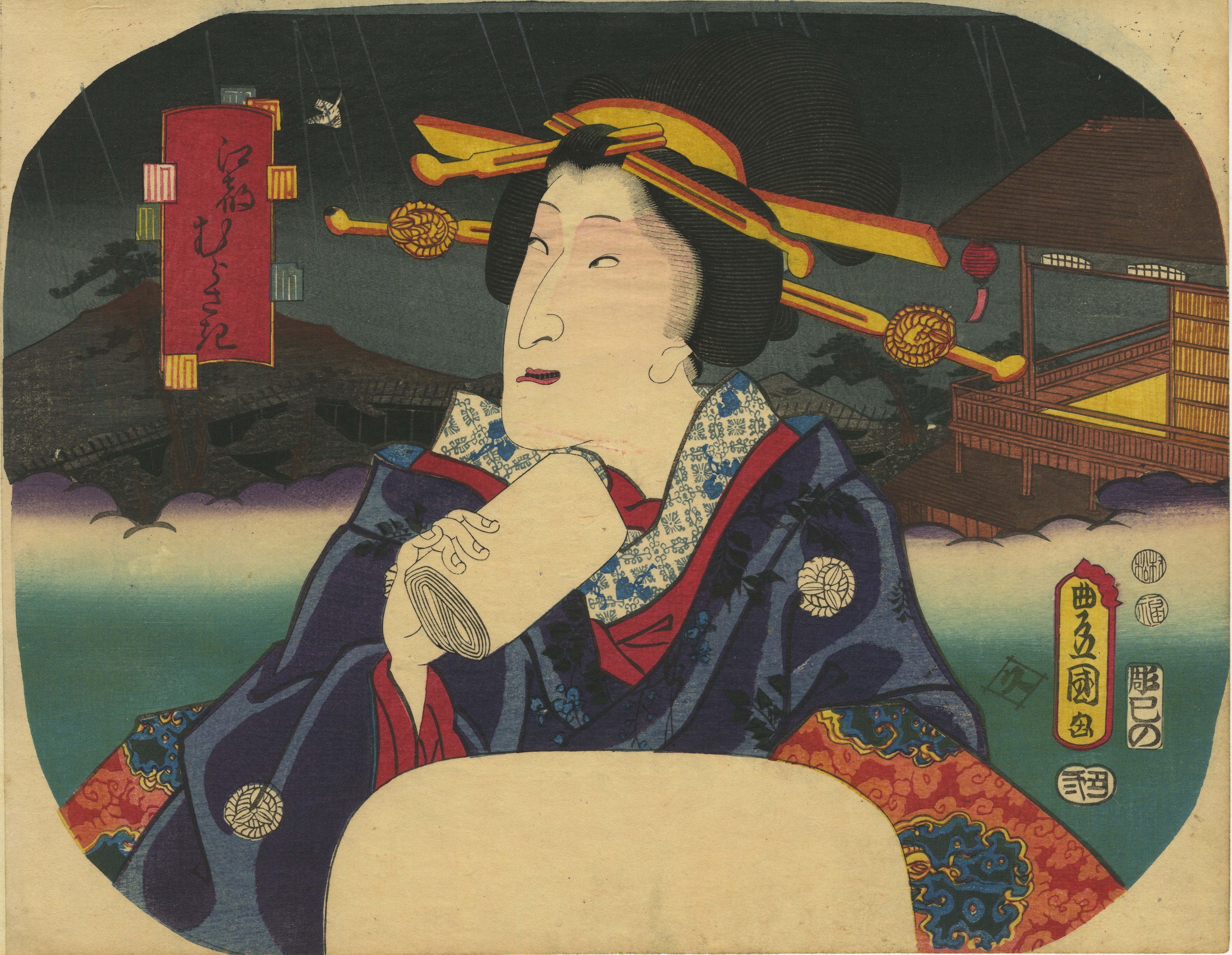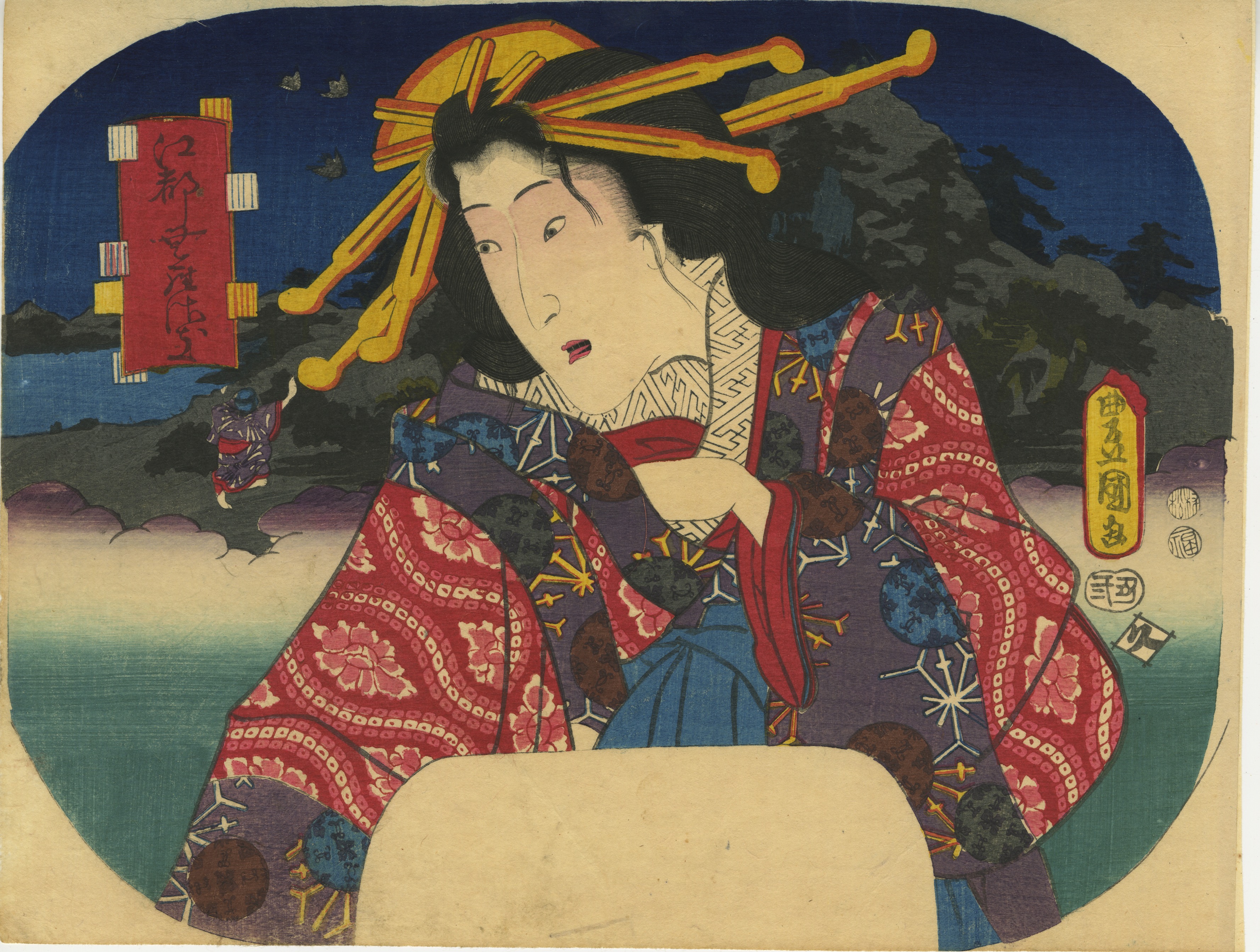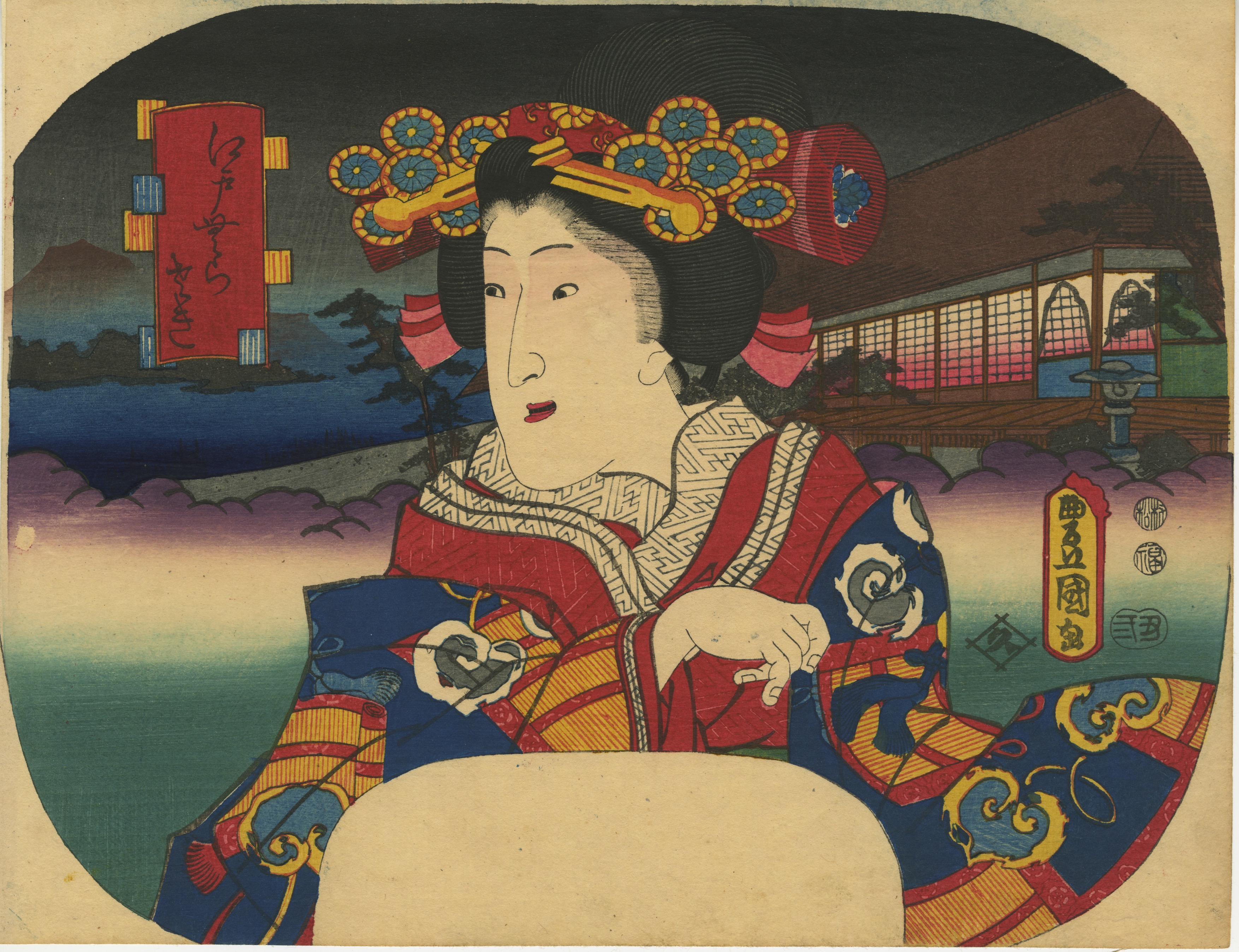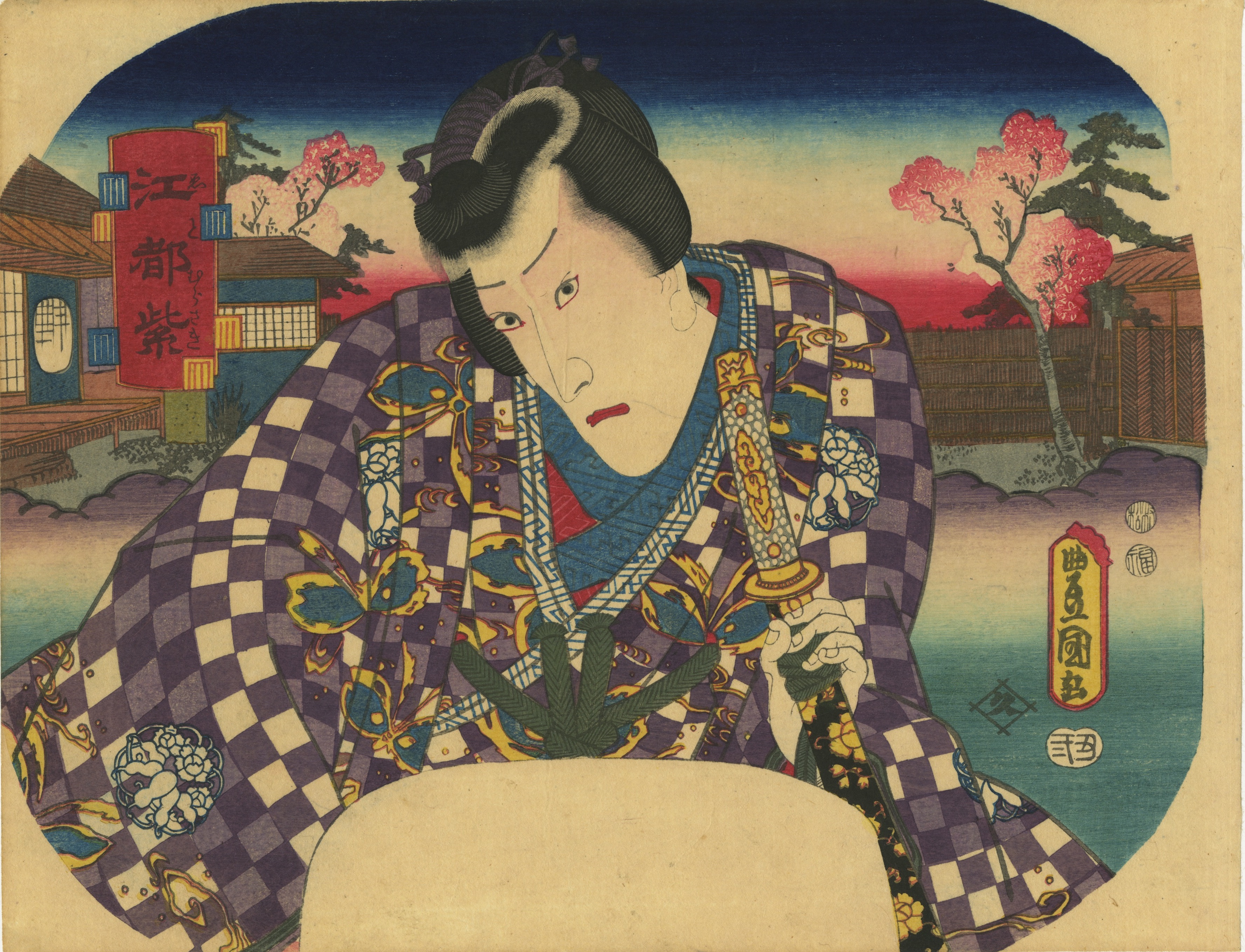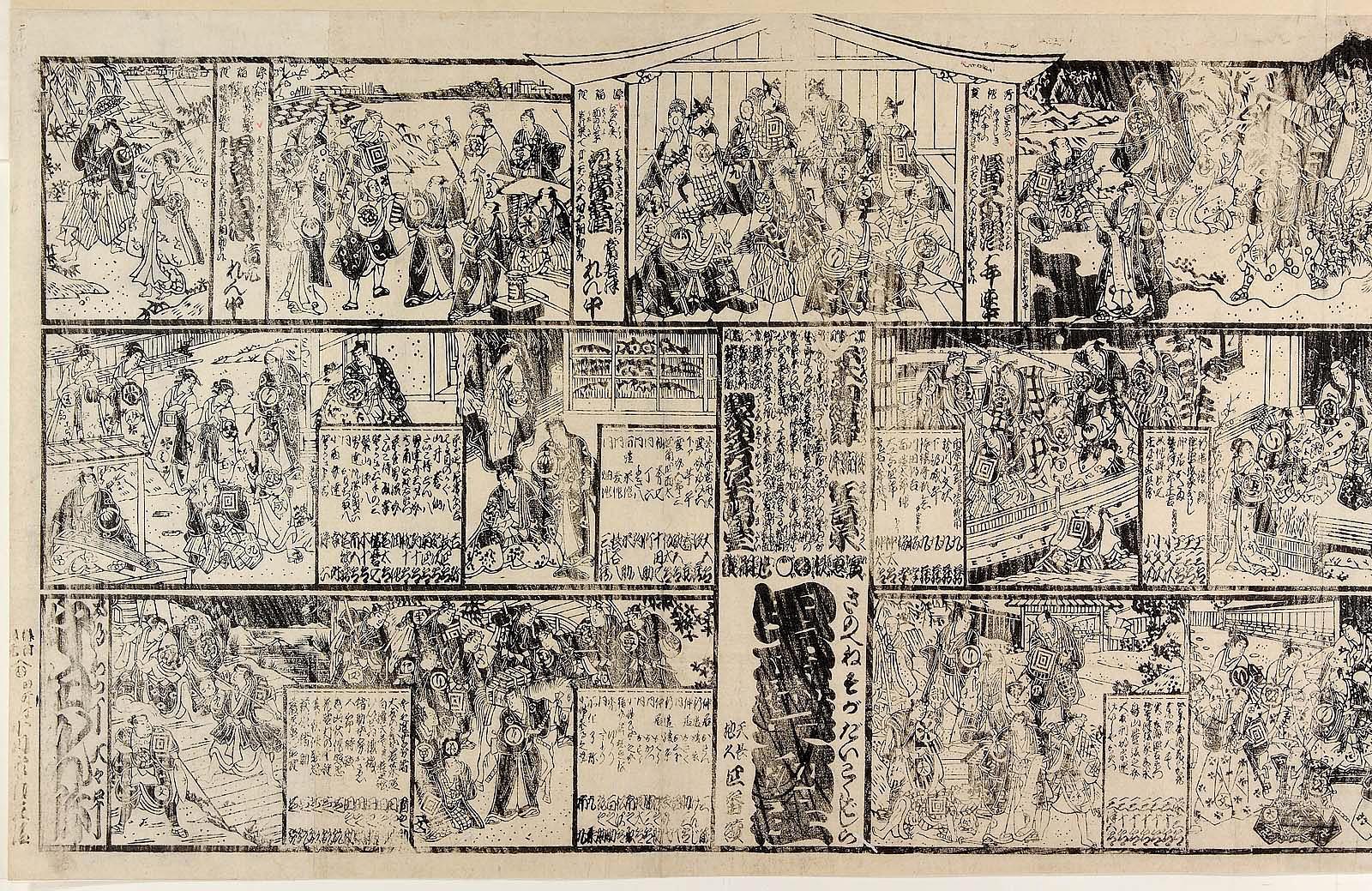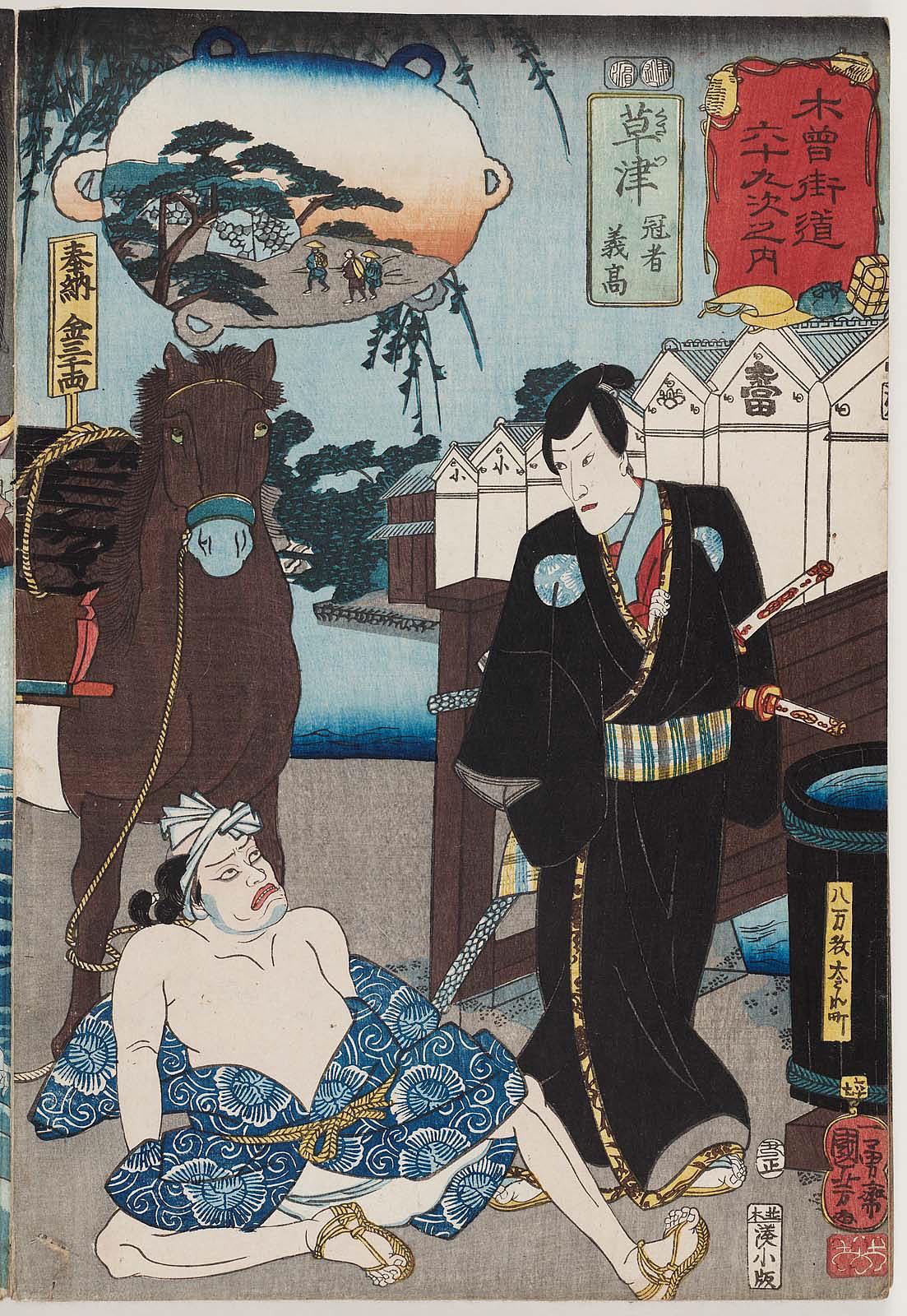-
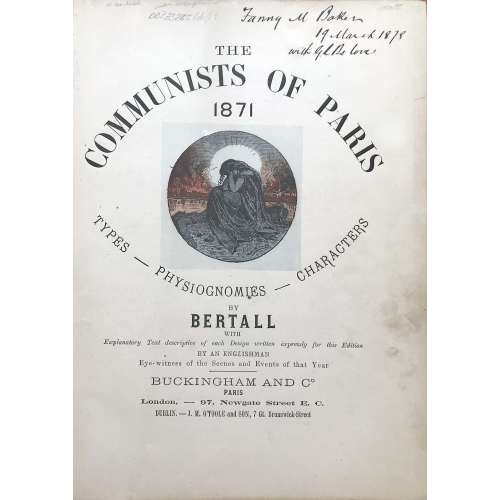 Folio (246 x 321 mm), hardbound in red-brown cloth with gilt lettering and decoration. Content, Introduction by J. E., September, 1873, Artist preface by Bertall, Paris, 1871-1873. Album with 40 hand-colored lithographs by Bertall, numbered 1 through 40, accompanied with extensive descriptions. Ex Libris: Baker. Carpe Diem. Markings: Janny M. Baker with J.L.B. Love, 19 March, 1878 in black ink.
Folio (246 x 321 mm), hardbound in red-brown cloth with gilt lettering and decoration. Content, Introduction by J. E., September, 1873, Artist preface by Bertall, Paris, 1871-1873. Album with 40 hand-colored lithographs by Bertall, numbered 1 through 40, accompanied with extensive descriptions. Ex Libris: Baker. Carpe Diem. Markings: Janny M. Baker with J.L.B. Love, 19 March, 1878 in black ink. -
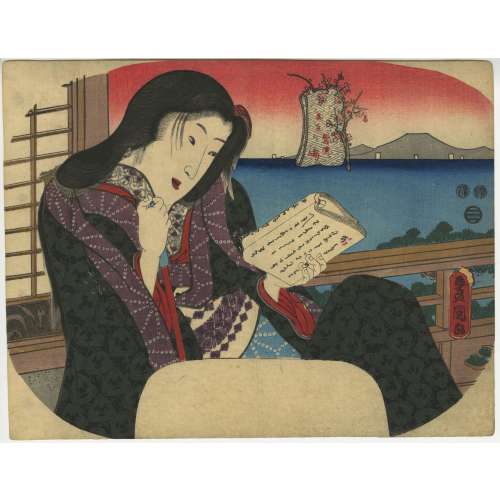 Artist: Utagawa Kunisada [歌川 国貞] a.k.a. Utagawa Toyokuni III [三代歌川豊国] (Japanese, 1786 – 1865). Signed: Toyokuni ga [豊国 画] in a red toshidama cartouche. Publisher: Ibaya Senzaburō [伊場屋仙三郎] (Japanese, c. 1815 – 1869). Double nanushi censor seals: Hama & Magome, Kaei 2-5 (1849 – 1852). An uncut fan print (uchiwa-e, 220 x 292 mm) depicts a beautiful woman sitting on a balcony overlooking a bay and reading a book. Above the book, there is an obi with a pattern of stripes or modified key fret motif, with lettering that reads: 菅原島 [Sugawara-jima] and 美立 [mitate]. The lettering and the blossoming plum branch next to the obi provide an allusion to Sugawara no Michizane [菅原 道真/菅原 道眞] (Japanese, 845 – 903) - a prominent scholar and poet of Heian period exiled from Kyoto to the island of Kyushu as a result of another courtier's slander. A legend says that his beloved plum tree was so fond of its master that it flew to Kyushu with Sugawara. The Davis Museum at Wellesley College describes the print as belonging to the series A Parody of Sugawara Stripe Patterns (Mitate Sugawara-jima). To make the fact of an allusion transparent, Kunisada had changed the usual way of writing "Sugawara stripes" from 菅原縞 to 菅原島 and "mitate" from 見立 to 美立. An unusual spelling was also used to provide additional information to the reader in other cultures. E.g. during the Prohibition Era, the West Coast United States speakeasy bars and bordellos misspelt the items on a menu ("scollops") or in a neon sign ("Martuni's") to tell: here we have more pleasures for you than you may have expected. After Tenpō reforms, the printing of bijin-ga (美人画, "picture of beautiful woman") images was restricted. Our print disguises a typical bijin-ga as an advertisement of an obi (帯, a kimono sash) fabric pattern. "The market of portraits was satisfied and the authorities fooled" [Rebecca Salter. Japanese popular prints. — Honolulu: University of Hawaii Press, 2006].
Artist: Utagawa Kunisada [歌川 国貞] a.k.a. Utagawa Toyokuni III [三代歌川豊国] (Japanese, 1786 – 1865). Signed: Toyokuni ga [豊国 画] in a red toshidama cartouche. Publisher: Ibaya Senzaburō [伊場屋仙三郎] (Japanese, c. 1815 – 1869). Double nanushi censor seals: Hama & Magome, Kaei 2-5 (1849 – 1852). An uncut fan print (uchiwa-e, 220 x 292 mm) depicts a beautiful woman sitting on a balcony overlooking a bay and reading a book. Above the book, there is an obi with a pattern of stripes or modified key fret motif, with lettering that reads: 菅原島 [Sugawara-jima] and 美立 [mitate]. The lettering and the blossoming plum branch next to the obi provide an allusion to Sugawara no Michizane [菅原 道真/菅原 道眞] (Japanese, 845 – 903) - a prominent scholar and poet of Heian period exiled from Kyoto to the island of Kyushu as a result of another courtier's slander. A legend says that his beloved plum tree was so fond of its master that it flew to Kyushu with Sugawara. The Davis Museum at Wellesley College describes the print as belonging to the series A Parody of Sugawara Stripe Patterns (Mitate Sugawara-jima). To make the fact of an allusion transparent, Kunisada had changed the usual way of writing "Sugawara stripes" from 菅原縞 to 菅原島 and "mitate" from 見立 to 美立. An unusual spelling was also used to provide additional information to the reader in other cultures. E.g. during the Prohibition Era, the West Coast United States speakeasy bars and bordellos misspelt the items on a menu ("scollops") or in a neon sign ("Martuni's") to tell: here we have more pleasures for you than you may have expected. After Tenpō reforms, the printing of bijin-ga (美人画, "picture of beautiful woman") images was restricted. Our print disguises a typical bijin-ga as an advertisement of an obi (帯, a kimono sash) fabric pattern. "The market of portraits was satisfied and the authorities fooled" [Rebecca Salter. Japanese popular prints. — Honolulu: University of Hawaii Press, 2006]. -
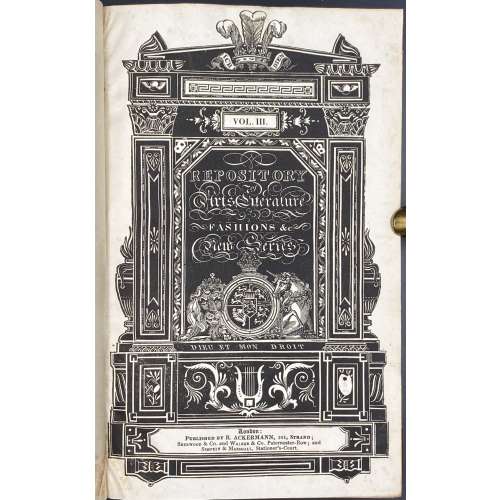 Pagination: [2] – letterpress title / blank, t.p. contents / to readers, [1] 2-368 [4 index], + 6 b/w (one folding) and 28 coloured plates (total 34). Collation: 4to; letterpress title, [A]1 B-Z4 Aa-Zz4 3A-3B4 3C3. Binding: 25 x 16 cm; gilt-ruled half-calf over marbled boards, flat spine, gilt-ruled compartments, gilt lettering. 5 aquatints by Thomas Rowlandson (British, 1757 – 1827): Table D'Hote; Consulting the Prophet; The Prophet discovering himself and exposing the deception; The Arrival in Paris; Liberality to infirm beggars on leaving Yrvi. References: Martin Hardie (1906), p.310 [LIB-2623.2021]; R. V. Tooley (1935), p. 26 [LIB-2641.2021]; J. R. Abbey (1953), Cat. № 212, p. 167 [LIB-2622.2021].
Pagination: [2] – letterpress title / blank, t.p. contents / to readers, [1] 2-368 [4 index], + 6 b/w (one folding) and 28 coloured plates (total 34). Collation: 4to; letterpress title, [A]1 B-Z4 Aa-Zz4 3A-3B4 3C3. Binding: 25 x 16 cm; gilt-ruled half-calf over marbled boards, flat spine, gilt-ruled compartments, gilt lettering. 5 aquatints by Thomas Rowlandson (British, 1757 – 1827): Table D'Hote; Consulting the Prophet; The Prophet discovering himself and exposing the deception; The Arrival in Paris; Liberality to infirm beggars on leaving Yrvi. References: Martin Hardie (1906), p.310 [LIB-2623.2021]; R. V. Tooley (1935), p. 26 [LIB-2641.2021]; J. R. Abbey (1953), Cat. № 212, p. 167 [LIB-2622.2021]. -
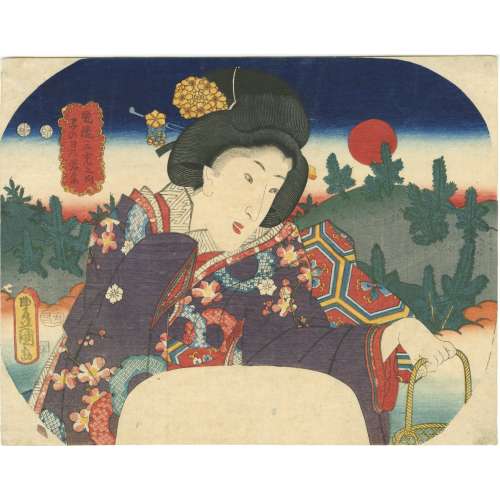 An uncut fan print shows a young woman holding a basket on a landscape background with hills and pines under a rising sun. Haruo Shirane: "Under the luni-solar calendar, the New Year coincided with the beginning of spring, making it the most important observance of the year for the aristocracy. In the Heian period, New Year ceremonies extended from New Year’s Day (Ganjitsu) to the Day of the Rat (Nenohi), which usually fell on the seventh day of the First Month, when courtiers went out to the fields (no), pulled up small pines, and gathered new herbs (wakana) as a prayer for long life. This ritual gradually spread to the provinces and to commoners, eventually resulting in the New Year practice of the gate pine (kadomatsu), in which a pair of small pines was placed at the gate of a house. A popular Heian-period painting topic representing the First Month was “prayers on the Day of the Rat” (Nenohi no asobi), which depicted the auspicious scene of pulling up small pines in a spring field. Both young herbs and gathering young herbs, particularly at Kasuga Field, became major poetic topics for the First Month, appearing in both the spring and celebration (ga) books of the Kokinshū (Collection of Japanese Poems Old and New, ca. 905). By the Kamakura period, the observance of the Day of the Rat had been abandoned at the imperial court, but the custom of gathering and eating young greens continued as the annual ceremony known as the Seven Grasses (Nanakusa). Note: The Heian-period ritual of pulling up the roots of small pines (komatsu ) on the first Day of the Rat derives from the homonyms ne (rat) and ne (root). Pulling up roots was auspicious, since it implied lengthening the year. The rising sun (hinode) was considered an auspicious sight, particularly at the beginning of the year". [Haruo Shirane, Japan and the Culture of the Four Seasons. Nature, Literature, and the Arts. — Columbia University, NY, 2012]. Title: Gathering of the young herbs on the Day of the Rat [子の日乃若菜] (Nenohi no wakana). Series: Three elegant sources of light [風流三光の内] (fūryū sankō no uchi); meaning the sun, the moon and the stars). Artist: Utagawa Kunisada [歌川 国貞]; a.k.a. Utagawa Toyokuni III [三代歌川豊国] (Japanese, 1786 – 1865). Signed: Toyokuni ga [豊国 画] in a yellow toshidama cartouche. Publisher’s seal: Izuzen (Marks: seal 06-029 | U103b) Date and double nanushi censor seals: Mera and Watanabe, Kaei 6 (1853). A similar theme can be found in Kunisadai's triptych published in about 1844 (HARA SHOBO):
An uncut fan print shows a young woman holding a basket on a landscape background with hills and pines under a rising sun. Haruo Shirane: "Under the luni-solar calendar, the New Year coincided with the beginning of spring, making it the most important observance of the year for the aristocracy. In the Heian period, New Year ceremonies extended from New Year’s Day (Ganjitsu) to the Day of the Rat (Nenohi), which usually fell on the seventh day of the First Month, when courtiers went out to the fields (no), pulled up small pines, and gathered new herbs (wakana) as a prayer for long life. This ritual gradually spread to the provinces and to commoners, eventually resulting in the New Year practice of the gate pine (kadomatsu), in which a pair of small pines was placed at the gate of a house. A popular Heian-period painting topic representing the First Month was “prayers on the Day of the Rat” (Nenohi no asobi), which depicted the auspicious scene of pulling up small pines in a spring field. Both young herbs and gathering young herbs, particularly at Kasuga Field, became major poetic topics for the First Month, appearing in both the spring and celebration (ga) books of the Kokinshū (Collection of Japanese Poems Old and New, ca. 905). By the Kamakura period, the observance of the Day of the Rat had been abandoned at the imperial court, but the custom of gathering and eating young greens continued as the annual ceremony known as the Seven Grasses (Nanakusa). Note: The Heian-period ritual of pulling up the roots of small pines (komatsu ) on the first Day of the Rat derives from the homonyms ne (rat) and ne (root). Pulling up roots was auspicious, since it implied lengthening the year. The rising sun (hinode) was considered an auspicious sight, particularly at the beginning of the year". [Haruo Shirane, Japan and the Culture of the Four Seasons. Nature, Literature, and the Arts. — Columbia University, NY, 2012]. Title: Gathering of the young herbs on the Day of the Rat [子の日乃若菜] (Nenohi no wakana). Series: Three elegant sources of light [風流三光の内] (fūryū sankō no uchi); meaning the sun, the moon and the stars). Artist: Utagawa Kunisada [歌川 国貞]; a.k.a. Utagawa Toyokuni III [三代歌川豊国] (Japanese, 1786 – 1865). Signed: Toyokuni ga [豊国 画] in a yellow toshidama cartouche. Publisher’s seal: Izuzen (Marks: seal 06-029 | U103b) Date and double nanushi censor seals: Mera and Watanabe, Kaei 6 (1853). A similar theme can be found in Kunisadai's triptych published in about 1844 (HARA SHOBO):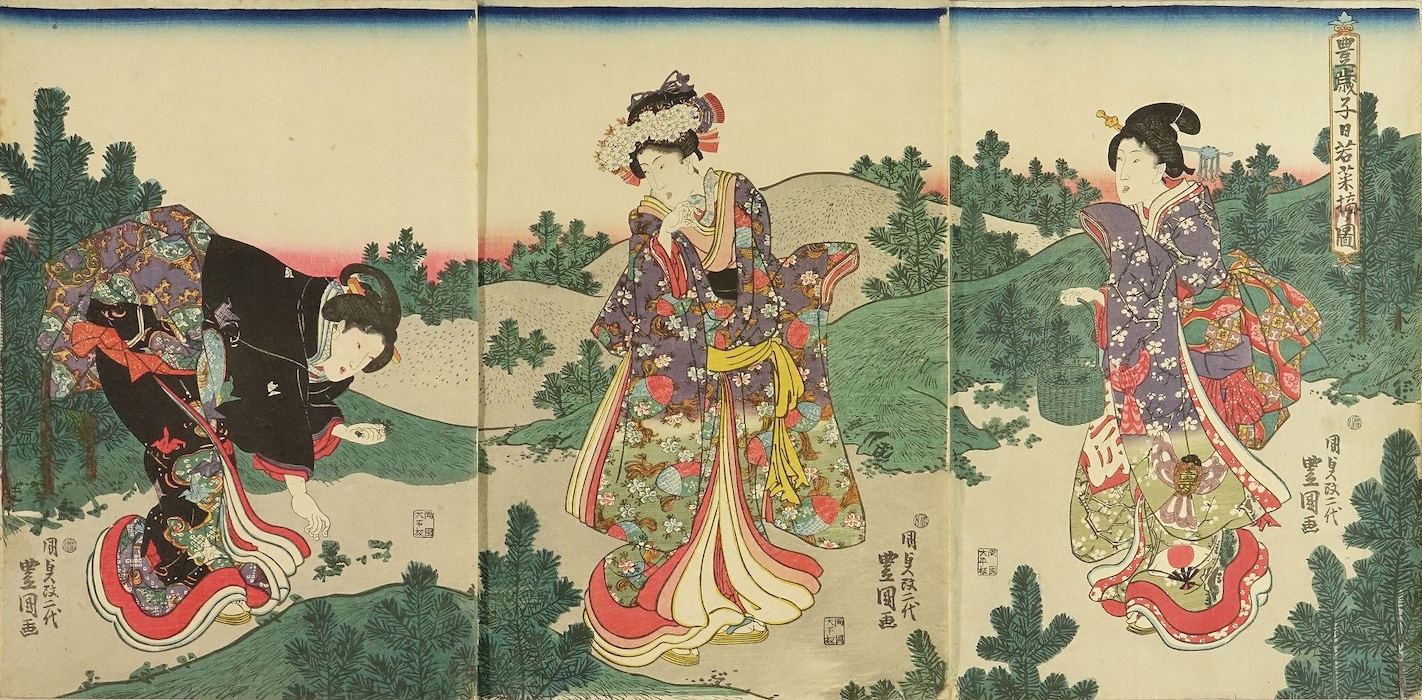
豊国三代「豊歳子日若菜摘ノ図」
-
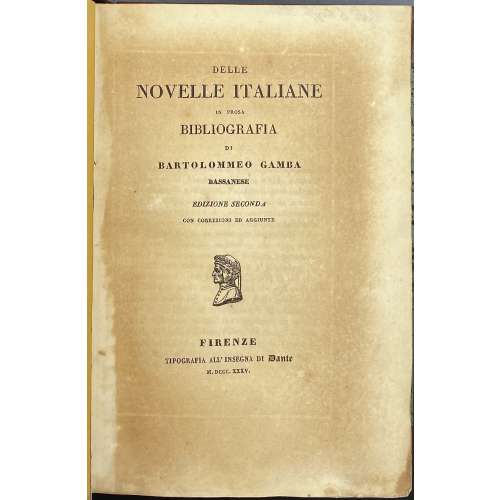 Title-page: DELLE | NOVELLE ITALIANE | IN PROSA | BIBLIOGRAFIA | DI | BARTOLOMMEO GAMBA | BASSANESE | EDIZIONE SECONDA | CON CORREZIONI ED AGGIUNTE | {publisher’s device} | FIRENZE | TIPOGRAFIA ALL’INSEGNA DI Dante | M.DCCC.XXXV. || Collation: 8vo; π8 1-198; an extra leaf between 18 and 19 (189, pp. 289-10, errata), leaf 11 unsigned, leaf 12 signed 11. Total 161 leaves plus 6 leaves of plates extraneous to collation; Plates (copperplate engravings): (1) Giovanni Boccaccio, (2) Angelo Firezuola (i.e. Agnolo Firenzuola), (3) Lorenzo Magalotti, (4) Gasparo Gozzi, and (5) Michele Colombo by Marco Comirato, and (6) Franco Sacchetti by Francesco Bosa. Pagination: [i-iii] iv-xv [xvi] [1-3] 4-290, index [16], total 322 pages plus 6 plates, unpaginated. Binding: 22.4 x 15 cm, modern brown half-morocco over green sprinkled boards, red label with gilt lettering, publisher’s yellow wrappers preserved. Edition: 2nd; the 1st edition was published in 1833. Contributors: Bartolommeo Gamba (Italian, 1766 – 1841) – author, complier. Marco Comirato (Italian, c. 1800 – 1869) – engraver. Francesco Bosa (Italian, ? – ?) – engraver. Sitters: Giovanni Boccaccio (Italian, 1313 –1375) Franco Sacchetti (Italian, c. 1335 – c. 1400) Agnolo Firenzuola] (Italian, 1493 – 1543) Lorenzo Magalotti (Italian, 1637 – 1712) Gasparo Gozzi (Italian, 1713 – 1786) Michele Colombo (Italian, 1747 – 1838)
Title-page: DELLE | NOVELLE ITALIANE | IN PROSA | BIBLIOGRAFIA | DI | BARTOLOMMEO GAMBA | BASSANESE | EDIZIONE SECONDA | CON CORREZIONI ED AGGIUNTE | {publisher’s device} | FIRENZE | TIPOGRAFIA ALL’INSEGNA DI Dante | M.DCCC.XXXV. || Collation: 8vo; π8 1-198; an extra leaf between 18 and 19 (189, pp. 289-10, errata), leaf 11 unsigned, leaf 12 signed 11. Total 161 leaves plus 6 leaves of plates extraneous to collation; Plates (copperplate engravings): (1) Giovanni Boccaccio, (2) Angelo Firezuola (i.e. Agnolo Firenzuola), (3) Lorenzo Magalotti, (4) Gasparo Gozzi, and (5) Michele Colombo by Marco Comirato, and (6) Franco Sacchetti by Francesco Bosa. Pagination: [i-iii] iv-xv [xvi] [1-3] 4-290, index [16], total 322 pages plus 6 plates, unpaginated. Binding: 22.4 x 15 cm, modern brown half-morocco over green sprinkled boards, red label with gilt lettering, publisher’s yellow wrappers preserved. Edition: 2nd; the 1st edition was published in 1833. Contributors: Bartolommeo Gamba (Italian, 1766 – 1841) – author, complier. Marco Comirato (Italian, c. 1800 – 1869) – engraver. Francesco Bosa (Italian, ? – ?) – engraver. Sitters: Giovanni Boccaccio (Italian, 1313 –1375) Franco Sacchetti (Italian, c. 1335 – c. 1400) Agnolo Firenzuola] (Italian, 1493 – 1543) Lorenzo Magalotti (Italian, 1637 – 1712) Gasparo Gozzi (Italian, 1713 – 1786) Michele Colombo (Italian, 1747 – 1838) -
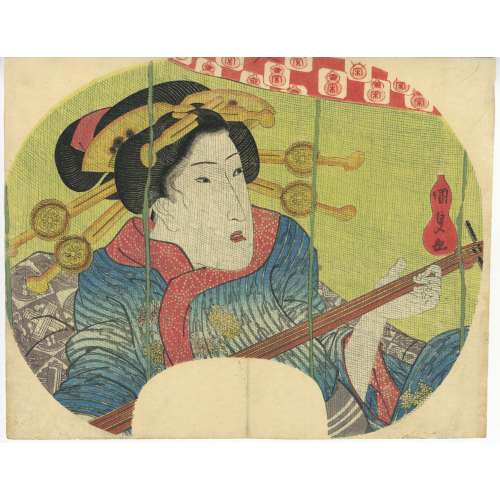 Artist: Utagawa Kunisada [歌川 国貞] a.k.a. Utagawa Toyokuni III [三代歌川豊国] (Japanese, 1786 – 1865). Signed: Kunisada ga [国貞画] in a red double-gourd cartouche Publisher: Unknown (no seal). Date: c. 1832 Izzard: "... red cloth decorated with the characters Yauan, one of Ichikawa Danjūrō VII [市川団十郎] (Japanese, 1791 – 1859) poetry names, and the name of his residence in Fukagawa. The absence of publisher's emblem and censorship seals may indicate that this was a privately issued print, not for public use". Ref.: [LIB-2967.2022] Utagawa Kunisada (1786 – 1865): His world revisited / Catalogue № 17, Exhibition March 17-21, 2021. — NY: Sebastian Izzard, LLC., 2021; p. 112-3, fig. 32). Size: Fan print (aiban uchiwa-e); 235 x 295 mm.
Artist: Utagawa Kunisada [歌川 国貞] a.k.a. Utagawa Toyokuni III [三代歌川豊国] (Japanese, 1786 – 1865). Signed: Kunisada ga [国貞画] in a red double-gourd cartouche Publisher: Unknown (no seal). Date: c. 1832 Izzard: "... red cloth decorated with the characters Yauan, one of Ichikawa Danjūrō VII [市川団十郎] (Japanese, 1791 – 1859) poetry names, and the name of his residence in Fukagawa. The absence of publisher's emblem and censorship seals may indicate that this was a privately issued print, not for public use". Ref.: [LIB-2967.2022] Utagawa Kunisada (1786 – 1865): His world revisited / Catalogue № 17, Exhibition March 17-21, 2021. — NY: Sebastian Izzard, LLC., 2021; p. 112-3, fig. 32). Size: Fan print (aiban uchiwa-e); 235 x 295 mm. -
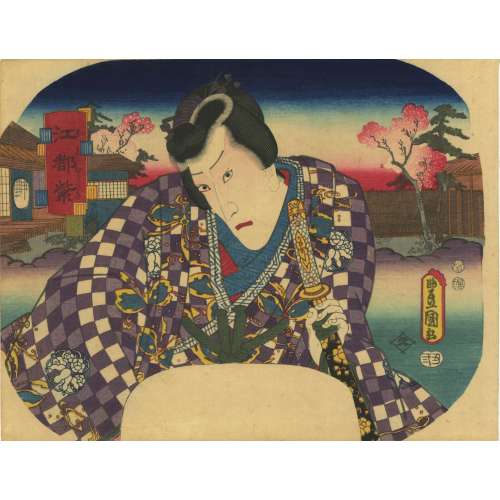 Utagawa Kunisada [歌川 国貞]; a.k.a. Utagawa Toyokuni III [三代歌川豊国] (Japanese, 1786 – 1865). Signed: Toyokuni ga [豊国 画] in a yellow toshidama cartouche. Publisher: Unknown, seal [久] Kyū (Japanese, fl. c. 1851 – 1861); (Marks 07-023 | U176a, possibly Sagamia Kyūzō). Date seal and double nanushi censor seals: Fuku & Muramatsu, Kaei 6, 2nd month (2/1853). Inscription in a red cartouche: (Purple of Edo // Purple of the Bay Capital) [江都むらさき] (Edo Murasaki), alluding to Murasaki Shikibu [紫 式部] (Japanese, c. 973/8 – c. 1014/31), the author of Genji Monogatari [源氏物語] (The Tale of Genji), a Heian period novel which was the source of a parody Nise Murasaki Inaka Genji [偐紫田舎源氏] (Fake Murasaki’s Rustic Genji) by Ryutei Tanehiko [柳亭種彦] (Japanese, 1783 – 1842). According to Horst Graebner: The actor is Ichikawa Danjūrō VIII. Ichikawa Danjūrō VIII [市川団十郎] (Japanese, 1823 – 1854); other names: Ichikawa Ebizō VI, Ichikawa Shinnosuke II. One of the series of Kunisada’s fan prints in this collection:
Utagawa Kunisada [歌川 国貞]; a.k.a. Utagawa Toyokuni III [三代歌川豊国] (Japanese, 1786 – 1865). Signed: Toyokuni ga [豊国 画] in a yellow toshidama cartouche. Publisher: Unknown, seal [久] Kyū (Japanese, fl. c. 1851 – 1861); (Marks 07-023 | U176a, possibly Sagamia Kyūzō). Date seal and double nanushi censor seals: Fuku & Muramatsu, Kaei 6, 2nd month (2/1853). Inscription in a red cartouche: (Purple of Edo // Purple of the Bay Capital) [江都むらさき] (Edo Murasaki), alluding to Murasaki Shikibu [紫 式部] (Japanese, c. 973/8 – c. 1014/31), the author of Genji Monogatari [源氏物語] (The Tale of Genji), a Heian period novel which was the source of a parody Nise Murasaki Inaka Genji [偐紫田舎源氏] (Fake Murasaki’s Rustic Genji) by Ryutei Tanehiko [柳亭種彦] (Japanese, 1783 – 1842). According to Horst Graebner: The actor is Ichikawa Danjūrō VIII. Ichikawa Danjūrō VIII [市川団十郎] (Japanese, 1823 – 1854); other names: Ichikawa Ebizō VI, Ichikawa Shinnosuke II. One of the series of Kunisada’s fan prints in this collection: -
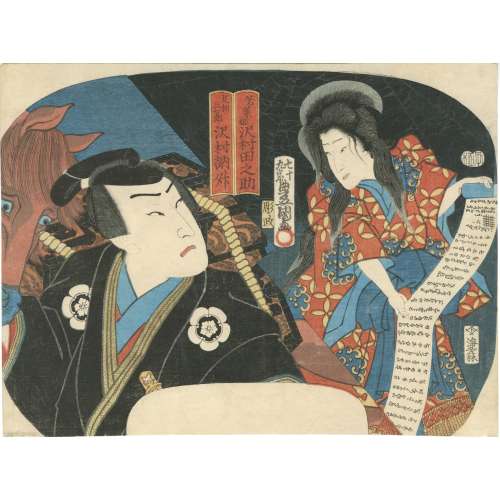 Artist: Utagawa Kunisada [歌川 国貞] a.k.a. Utagawa Toyokuni III [三代歌川豊国] (Japanese, 1786 – 1865). Artist signature: By the brush of the 79-year-old Toyokuni [七十九歳豊國画] (Nanajūkyū-sai Toyokuni ga). Publisher: Ebiya Rinnosuke [海老屋林之助] (Japanese, fl. c. 1832 – 1895); seal: ト/ 海老林 (to, Ebirin). Block carver: Matsushima Masakichi [松島政吉]; seal: carved by Masa [彫政] (Hori Masa). Combined date seal and kiwame censor seal: [子極] 1864 (Bunkyū 4/Genji 1). Media: Untrimmed fan print (uchiwa-e), 223 x 297 mm. Inscription in the cartouches: (R) Wakana-hime [若菜姫], Sawamura Tanosuke III [沢村田之助]; (L) Ashikaga Sanshichirō [足利三七郎], Sawamura Tosshō II [沢村訥升]. Play: Kinoene Soga Daikoku-bashira [甲子曽我大国柱], performed at the Morita theatre [森田座・守田座] (Morita-za) in 1864 (Bunkyū 4/Genji 1), 2nd month (see playbill at MFA-Boston Collection). Playwright: Muraoka Kōji II [村岡幸治]. Actors and Characters: Sawamura Tanosuke III [三代目沢村田之助] (Japanese, 1859 – 1878); other names: Shozan [曙山] (poetry name), Sawamura Yoshijirō I [初代沢村由次郎], here in the role of Princess Wakana [若菜姫] (Wakana-hime) (R). The story about Princess Wakana, Shiranui Monogatari, was written by Ryukatei Tanekazu [柳下亭種員] (Japanese, 1807 – 1858) and published as a 90-volume book of comics between 1849 and 1855. ...The tale revolves around the clash between the Kikuchi and Ōtomo clans. Princess Wakana’s father Ōtomo Sōrin [大友 宗麟] (1530 – 1587) was killed in a battle, and his spirit demanded revenge. To appease her late father's spirit, Princes Wakana acquired the power of the Earth Spider. She often appears in prints with a magic scroll, which helps her fight various enemies. Sawamura Tosshō II [二代目沢村訥升] (Japanese, 1854 – 1879); other names: Kōga [高賀] (poetry name), Sawamura Genpei II [二代目沢村源平], Sawamura Sōjūrō [澤村宗十郎], Suketakaya Takasuke IV [四代目助高屋高助], Sawamura Tosshi VI [六代目澤村訥子] (poetry name), here in the role of Ashikaga Sanshichirō [足利三七郎] (L) with a horse. According to Markus Sesko, the scene comes from the kabuki play Umakiri (馬斬り) by Tatsuoka Mansaku [辰岡万作] (17432 – 1809), which premiered in 1794. It was later assimilated into the Kabuki play Kozotte Mimasu Kuruwa no Datezome [襷廓三升伊達染], which was staged in the 1st lunar month of 1853 at the Nakamura-za. Umakiri is based on a Kyōgen play featured in Hideyoshi’s biography Taikōki [太閤記]. Its plot is that Ashikaga Sanchichirō Yoshitaka [足利三七郎義孝・義高], who is supposed to allude to Nobunaga’s son Oda Sanshichirō Nobutaka [織田三七郎信孝], attacks and kills a horse that is carrying 3,000 ryō (金三千両), money Mashiba Hisayoshi [真柴久吉] (an allusion to Hashiba Hideyoshi [羽柴秀吉]) had sent to be donated to a shrine on Mt. Kōya. The surrounding people try to catch him, but when they hear it is Yoshitaka who killed the horse, they fall to the ground and prostrate, and Yoshitaka leisurely leaves with the money. The plot is very simple, but Yoshitaka’s dashing appearance makes it very pleasing to watch. There are also prints that quote the main protagonist as Ashikaga Sanshichirō Harutaka [足利三七郎春高], and there is another title for the play, Sanzen-Ryō Kogane no Kurairi [三千両黄金蔵入] (Pocketing 3,000 ryō of gold). For reference, see also the BLOG. What these two characters are doing in one play remains a riddle. As Mr Graebner comments: "Most kabuki plays were only performed for one season (two months), and the books were lost. The playwrights have repeatedly used parts of plots from other plays, they have adopted characters, sometimes with the same or similar names. What can be found is the Kabuki Playbill (Tsuji banzuke) with cast and roles; the content is lost". Acknowledgements: Special thanks to Horst Graebner of the Kunisada Project and to Markus Sesko of The Metropolitan Museum, NY, for the analysis of the image and their invaluable contribution. For reference, see also:
Artist: Utagawa Kunisada [歌川 国貞] a.k.a. Utagawa Toyokuni III [三代歌川豊国] (Japanese, 1786 – 1865). Artist signature: By the brush of the 79-year-old Toyokuni [七十九歳豊國画] (Nanajūkyū-sai Toyokuni ga). Publisher: Ebiya Rinnosuke [海老屋林之助] (Japanese, fl. c. 1832 – 1895); seal: ト/ 海老林 (to, Ebirin). Block carver: Matsushima Masakichi [松島政吉]; seal: carved by Masa [彫政] (Hori Masa). Combined date seal and kiwame censor seal: [子極] 1864 (Bunkyū 4/Genji 1). Media: Untrimmed fan print (uchiwa-e), 223 x 297 mm. Inscription in the cartouches: (R) Wakana-hime [若菜姫], Sawamura Tanosuke III [沢村田之助]; (L) Ashikaga Sanshichirō [足利三七郎], Sawamura Tosshō II [沢村訥升]. Play: Kinoene Soga Daikoku-bashira [甲子曽我大国柱], performed at the Morita theatre [森田座・守田座] (Morita-za) in 1864 (Bunkyū 4/Genji 1), 2nd month (see playbill at MFA-Boston Collection). Playwright: Muraoka Kōji II [村岡幸治]. Actors and Characters: Sawamura Tanosuke III [三代目沢村田之助] (Japanese, 1859 – 1878); other names: Shozan [曙山] (poetry name), Sawamura Yoshijirō I [初代沢村由次郎], here in the role of Princess Wakana [若菜姫] (Wakana-hime) (R). The story about Princess Wakana, Shiranui Monogatari, was written by Ryukatei Tanekazu [柳下亭種員] (Japanese, 1807 – 1858) and published as a 90-volume book of comics between 1849 and 1855. ...The tale revolves around the clash between the Kikuchi and Ōtomo clans. Princess Wakana’s father Ōtomo Sōrin [大友 宗麟] (1530 – 1587) was killed in a battle, and his spirit demanded revenge. To appease her late father's spirit, Princes Wakana acquired the power of the Earth Spider. She often appears in prints with a magic scroll, which helps her fight various enemies. Sawamura Tosshō II [二代目沢村訥升] (Japanese, 1854 – 1879); other names: Kōga [高賀] (poetry name), Sawamura Genpei II [二代目沢村源平], Sawamura Sōjūrō [澤村宗十郎], Suketakaya Takasuke IV [四代目助高屋高助], Sawamura Tosshi VI [六代目澤村訥子] (poetry name), here in the role of Ashikaga Sanshichirō [足利三七郎] (L) with a horse. According to Markus Sesko, the scene comes from the kabuki play Umakiri (馬斬り) by Tatsuoka Mansaku [辰岡万作] (17432 – 1809), which premiered in 1794. It was later assimilated into the Kabuki play Kozotte Mimasu Kuruwa no Datezome [襷廓三升伊達染], which was staged in the 1st lunar month of 1853 at the Nakamura-za. Umakiri is based on a Kyōgen play featured in Hideyoshi’s biography Taikōki [太閤記]. Its plot is that Ashikaga Sanchichirō Yoshitaka [足利三七郎義孝・義高], who is supposed to allude to Nobunaga’s son Oda Sanshichirō Nobutaka [織田三七郎信孝], attacks and kills a horse that is carrying 3,000 ryō (金三千両), money Mashiba Hisayoshi [真柴久吉] (an allusion to Hashiba Hideyoshi [羽柴秀吉]) had sent to be donated to a shrine on Mt. Kōya. The surrounding people try to catch him, but when they hear it is Yoshitaka who killed the horse, they fall to the ground and prostrate, and Yoshitaka leisurely leaves with the money. The plot is very simple, but Yoshitaka’s dashing appearance makes it very pleasing to watch. There are also prints that quote the main protagonist as Ashikaga Sanshichirō Harutaka [足利三七郎春高], and there is another title for the play, Sanzen-Ryō Kogane no Kurairi [三千両黄金蔵入] (Pocketing 3,000 ryō of gold). For reference, see also the BLOG. What these two characters are doing in one play remains a riddle. As Mr Graebner comments: "Most kabuki plays were only performed for one season (two months), and the books were lost. The playwrights have repeatedly used parts of plots from other plays, they have adopted characters, sometimes with the same or similar names. What can be found is the Kabuki Playbill (Tsuji banzuke) with cast and roles; the content is lost". Acknowledgements: Special thanks to Horst Graebner of the Kunisada Project and to Markus Sesko of The Metropolitan Museum, NY, for the analysis of the image and their invaluable contribution. For reference, see also: -
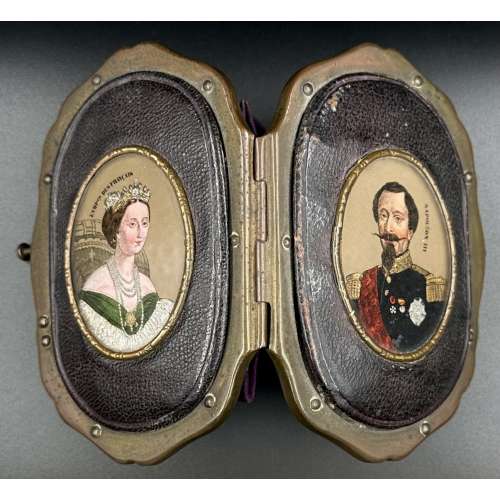 Coin purse, or porte-monnaie, made of patinated copper alloy, full-grain brown leather outside and purple inside, with a clutch and a hinge, and an oval miniature bust portrait on each side, painted in colour with gold and silver, by an anonymous artist after Franz Xaver Winterhalter, inscribed NAPOLÉON III and L'IMPCE DES FRANÇAIS, respectively, under glass. Dimensions: 97 x 67 x 18 mm. Contributors: Napoleon III [Charles Louis Napoléon Bonaparte] (French, 1808 – 1873) – character/sitter. Eugénie de Montijo [María Eugenia Ignacia Agustina de Palafox y Kirkpatrick] (Spanish-French, 1826 – 1920) – character/sitter. Franz Xaver Winterhalter (German, 1805 – 1873) – artist.
Coin purse, or porte-monnaie, made of patinated copper alloy, full-grain brown leather outside and purple inside, with a clutch and a hinge, and an oval miniature bust portrait on each side, painted in colour with gold and silver, by an anonymous artist after Franz Xaver Winterhalter, inscribed NAPOLÉON III and L'IMPCE DES FRANÇAIS, respectively, under glass. Dimensions: 97 x 67 x 18 mm. Contributors: Napoleon III [Charles Louis Napoléon Bonaparte] (French, 1808 – 1873) – character/sitter. Eugénie de Montijo [María Eugenia Ignacia Agustina de Palafox y Kirkpatrick] (Spanish-French, 1826 – 1920) – character/sitter. Franz Xaver Winterhalter (German, 1805 – 1873) – artist.
-
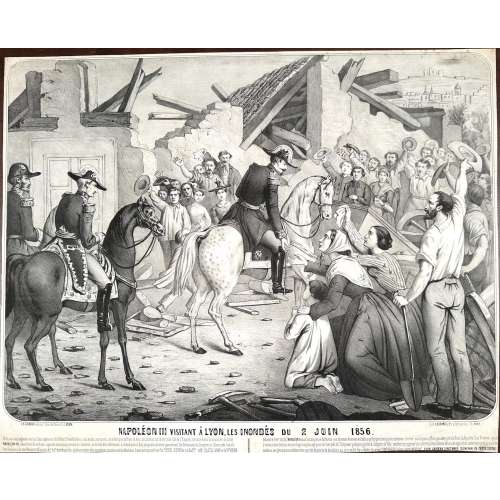 Lithography poster on wove paper, 492 x 614 mm; black ink stamp “5036” to reverse, vertical centerfold. Image in frame; under the frame left: "J. B. Gadola, éditeur. Cours de Brosses 1, à LYON."; right: "Lith LAURANT & Cie r. de Bernardins 34, Paris." Title and text below the image. Jean-Baptiste Gadola (French, 1818 – 1870) – publisher.
Lithography poster on wove paper, 492 x 614 mm; black ink stamp “5036” to reverse, vertical centerfold. Image in frame; under the frame left: "J. B. Gadola, éditeur. Cours de Brosses 1, à LYON."; right: "Lith LAURANT & Cie r. de Bernardins 34, Paris." Title and text below the image. Jean-Baptiste Gadola (French, 1818 – 1870) – publisher. -
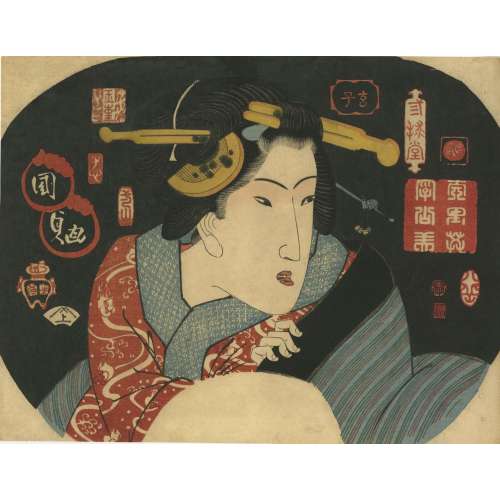 Artist: Utagawa Kunisada [歌川 国貞] a.k.a. Utagawa Toyokuni III [三代歌川豊国] (Japanese, 1786 – 1865). Publisher: Iseya Sōemon [伊勢屋惣右衛門] (Japanese, c. 1776 – 1862). Signed: Kunisada ga within a double toshidama. Date-kiwame seals: Bunsei 11 (1828).
Artist: Utagawa Kunisada [歌川 国貞] a.k.a. Utagawa Toyokuni III [三代歌川豊国] (Japanese, 1786 – 1865). Publisher: Iseya Sōemon [伊勢屋惣右衛門] (Japanese, c. 1776 – 1862). Signed: Kunisada ga within a double toshidama. Date-kiwame seals: Bunsei 11 (1828). -
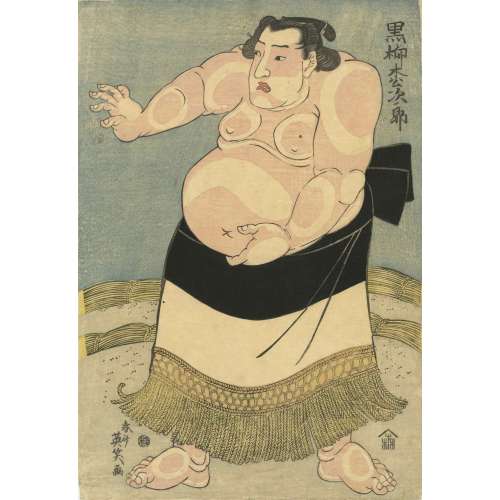 This print was sold to me with the following description: "Ikkansai EISHO (Fl. early 19th c.). A portrait of the wrestler Kuroyanagi Matsujiro, ring name Kumagatake Inosuke. Eisho was a pupil of Eishi. Published c. 1820s by Uoya Eikichi. Signed Shunsai Eisho ga." As a result of our joint effort with my beloved sister, we have so far found the following: The artis is mentioned in The Hotei Encyclopedia of Japanese Woodblock Prints, 2005, Vol 2; p. 438 under the name of Harukawa Eichō. From this source we learned that the artist was active from about 1818 till 1844, and was a print designer in Kyoto. He was a student first of Harukawa Goshichi and later studied in Edo (Tokyo) with Keisai Eisen, when he assumed the art name 'Eichō'. Other names: Shunsai. The Japanese web page dedicated to Harukawa Eichō provides more details: The artist lived from the 4th year of Tenmei ( 1784 ) to the first year of Kaei ( 1848 ). He was a student of Harukawa Goshichi, Kikukawa Eizan as well as of Keisai Eisen. His popular name was Kamenosuke. He was from Kyoto. He took "gagō" (artistic names) of Eishō when he was a student of Harukawa Goshichi; later, when he became a student of Kikukawa Eizan and Keisai Eisen he took the name of Kikukawa Eichō. The artist was mostly known for his bijinga (beautiful women) prints as well as kanazōshi illustrations. Nothing is said anywhere about his sumo prints, though the reference to another Kyushu sumo wrestler portrait has been found. The sumo wrestler Kuroyanagi Matsujiro is also a somewhat obscure figure: information about his life and career is quite inconsistent. It may so happened that two different persons were combined together. Wikipedia page about Aoi Aso Jinja, a Shinto shrine in Hitoyoshi in Kumamoto prefecture, tells us the following:This information has some inconsistencies already. If our hero was born in 1807 and promoted to ōzeki at the age of 32, it should have been the year 1839, not 1847. I found Kumagatake Isuke at "Sumo Reference" website:
This print was sold to me with the following description: "Ikkansai EISHO (Fl. early 19th c.). A portrait of the wrestler Kuroyanagi Matsujiro, ring name Kumagatake Inosuke. Eisho was a pupil of Eishi. Published c. 1820s by Uoya Eikichi. Signed Shunsai Eisho ga." As a result of our joint effort with my beloved sister, we have so far found the following: The artis is mentioned in The Hotei Encyclopedia of Japanese Woodblock Prints, 2005, Vol 2; p. 438 under the name of Harukawa Eichō. From this source we learned that the artist was active from about 1818 till 1844, and was a print designer in Kyoto. He was a student first of Harukawa Goshichi and later studied in Edo (Tokyo) with Keisai Eisen, when he assumed the art name 'Eichō'. Other names: Shunsai. The Japanese web page dedicated to Harukawa Eichō provides more details: The artist lived from the 4th year of Tenmei ( 1784 ) to the first year of Kaei ( 1848 ). He was a student of Harukawa Goshichi, Kikukawa Eizan as well as of Keisai Eisen. His popular name was Kamenosuke. He was from Kyoto. He took "gagō" (artistic names) of Eishō when he was a student of Harukawa Goshichi; later, when he became a student of Kikukawa Eizan and Keisai Eisen he took the name of Kikukawa Eichō. The artist was mostly known for his bijinga (beautiful women) prints as well as kanazōshi illustrations. Nothing is said anywhere about his sumo prints, though the reference to another Kyushu sumo wrestler portrait has been found. The sumo wrestler Kuroyanagi Matsujiro is also a somewhat obscure figure: information about his life and career is quite inconsistent. It may so happened that two different persons were combined together. Wikipedia page about Aoi Aso Jinja, a Shinto shrine in Hitoyoshi in Kumamoto prefecture, tells us the following:This information has some inconsistencies already. If our hero was born in 1807 and promoted to ōzeki at the age of 32, it should have been the year 1839, not 1847. I found Kumagatake Isuke at "Sumo Reference" website:Kuroki Matsujiro (黒木松次郎) was born in the village of Itsuki in Kuma district, Kumamoto prefecture, island of Kyushu in Bunka era, 4th year (1807). Since from his childhood he was blessed by great physique and tough strength. He had affection for sumo. At the age of 18 he became a sumo student of Kumamoto Shimakawa Ikuhei and took the name of Toyama Hidekichi (遠山日出吉). At the age of 23 (1830), he entered sumo stables in Kyoto, mastered the art of taming of young horses, and his talents improved. At the age of 31 he went to Edo, and became a disciple of the ōzeki Oitekaze Kitaro of Hirado domain in Hizen province, also from Kyushu island. After that, he changed his name and became Kuroyanagi Matsujiro (黒柳松次郎 – as on the print). In 1847 (Bunka era, 4th year) he distinguished himself by advancing to the first grade, and at the age of 32 he was promoted to ozeki level, becoming sekitori. After changing his name to Kuma-ga-take Inosuke (熊ヶ嶽猪之介 / くまがたけいのすけ) he displayed further efforts, and became one of the strongmen that fermented sumo wrestling in Edo. In 1853 (Kaei era, 6th year) he retired and returned to his village, becoming an employee as a strongman of Sagara domain (相良藩), and worked hard as instructor of the sumo training hall to train successors until 1855 (Ansei era, 2nd year) when he passed away at the age of 48. Even today Kuma-ga-take's home exists in Itsukimura (his native village). Also, on those grounds a descendant of Kuma-ga-take runs minshuku (guest house) that bears the name of "The Kuroki Pension (lodging) ", and tourists come to visit from various parts of Japan. In 2015, tenth month, within the borders of Aoi Aso Shrine there was built a gravestone publicly honoring Kuma-ga-take Inosuke, sumo wrestler from Edo / of Edo period.
The real name is the same, the ring name Kuroyanagi Matsujiro is the same, however, the date of birth here is 1815. He fought from 1836 till 1853 - which is quite similar to "At the age of 31 he went to Edo, and became a disciple of the ōzeki Oitekaze Kitaro". Though, in 1836 he might be 29 years old. His bouts are listed from spring 1841 to spring 1848 under the name of Kuroyanagi and from winter 1848 till spring 1853 he listed under the name of Kumagatake Isuke [Inosuke].Highest Rank Maegashira 4 Real Name Kuroki Birth Date 1815 Shusshin Kumamoto-ken, Kuma-gun Death Date March 6, 1855 (40 years) Heya Oitekaze Shikona Kuroyanagi Matsujiro - Kumagatake Isuke Hatsu Dohyo 1836.02 (Sandanme) Intai 1853.02 On another important sumo history website, I found that Kuroyanagi first appeared at ring in the spring of 1823 (he might have been 16 years old then, which does not seem right). Then, in the winter tournament of 1848 Kuroyanagi took the name Kumagatake. At the spring tournament of 1853 Kumagatake (Kuroyanagi) retired. This is quite consistent so far.
Then, I found Oitekaze Kitaro, allegedly the teacher of Kuroyanagi.
Everything look good with an exception of ring names (shikona): Kuroyanagi Matsujiro (1823-1828) - Kuroyanagi Sumiemon (1829-30) - Oitekaze Kitaro (1831-1839). May it be that Sato Matsutaro fought under the name of Kuroyanagi Matsujiro until Kuroki Matsujiro took this name from his master? I don't have another explanation of the enigma. What we know is that we have a portrait of a sumo wrestler called Kuroyanagi Matsujiro from Kyushu, but we don't know whether this was the one from Kumamoto (Kumagatake Inosuke, 1807/1815-1855) or the other from Kanagawa (Oitekaze Kitaro, 1799-1865). Subsequently, we may declare that the artist is Shunsai Eishō, a.k.a.Harukawa Eichō from Eishi school (The Hotei Encyclodepdia, p. 524), we can date the print from 1818 to 1844, and only tell that the wrestler is Kuroyanagi Matsujiro from Kyushu (either Kumagatake Inosuke or Oitekaze Kitaro). The publisher of the print is Moriya Jihei (Marks №353, p. 243-5). That's it.Highest Rank Ozeki Real Name SATO Matsujiro (Matsutaro#) Birth Date 1799 Shusshin Kanagawa-ken, Tsukui-gun Death Date May 4, 1865 (66 years) Heya Oitekaze Shikona Kuroyanagi Matsujiro - Kuroyanagi Sumiemon - Oitekaze Kitaro Hatsu Dohyo 1817.10 (Jonokuchi) Intai 1839.03 -
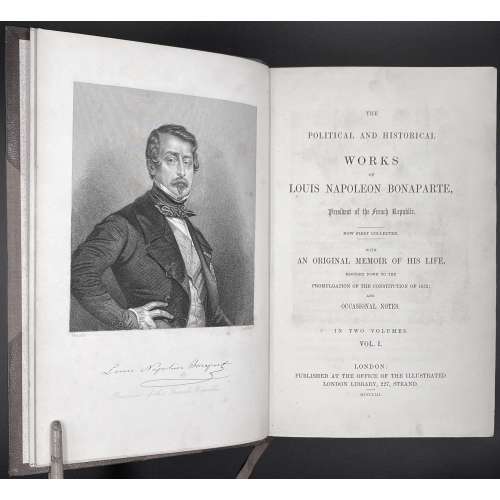 [Bonaparte, Louis Napoleon]. The Political and Historical Works of Louis Napoleon Bonaparte, President of the French Republic, Now First Collected With An Original Memoir of His Life, Brought Down to the Promulgation of the Constitution of 1852; and Occasional Notes, Complete in Two Volumes. London: Illustrated London Library, MDCCCLII [1852]. Collation: Vol. 1: [i-v] vi [vii-viii (blank)] [1] 2-462 [463,464 (blank)]; Vol. 2: [1-3] 4-439 [440]. Size: 22.8 x 14.8 cm (8vo), each. Binding: hardcover; half red morocco and cloth boards, five raised bands, gilt title and decoration, top edge gilt. Frontispiece portrait of Louis Napoleon Bonaparte in Vol. 1. Condition: Very good, rubbing to outer joints, leather corners, faint foxing to endpapers, ownership signature on half-title. Internally bright and unmarked. In binding by Brentano's, New York.
[Bonaparte, Louis Napoleon]. The Political and Historical Works of Louis Napoleon Bonaparte, President of the French Republic, Now First Collected With An Original Memoir of His Life, Brought Down to the Promulgation of the Constitution of 1852; and Occasional Notes, Complete in Two Volumes. London: Illustrated London Library, MDCCCLII [1852]. Collation: Vol. 1: [i-v] vi [vii-viii (blank)] [1] 2-462 [463,464 (blank)]; Vol. 2: [1-3] 4-439 [440]. Size: 22.8 x 14.8 cm (8vo), each. Binding: hardcover; half red morocco and cloth boards, five raised bands, gilt title and decoration, top edge gilt. Frontispiece portrait of Louis Napoleon Bonaparte in Vol. 1. Condition: Very good, rubbing to outer joints, leather corners, faint foxing to endpapers, ownership signature on half-title. Internally bright and unmarked. In binding by Brentano's, New York. -
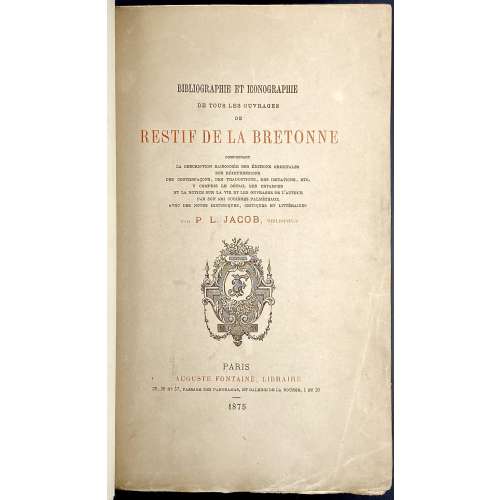 Title: BIBLIOGRAPHIE ET ICONOGRAPHIE | DE TOUS LES OUVRAGES | DE | RESTIF DE LA BRETONNE | COMPRENANT | LA DESCRIPTION RAISONNÉE DES ÉDITIONS ORIGINALES | DES RÉIMPRESSIONS | DES CONTREFAÇONS, DES TRADUCTIONS, DES IMITATIONS, ETC. | Y COMPRIS LE DÉTAIL DES ESTAMPES | ET LA NOTICE SUR LA VIE ET LES OUVRAGES DE L'AUTEUR | PAR SON AMI CUBIÈRES PALMÉZEAUX | AVEC DES NOTES HISTORIQUES, CRITIQUES ET LITTÉRAIRES | PAR P. L. JACOB, BIBLIOPHILE | {Publisher’s device} | PARIS | AUGUSTE FONTAINE, LIBRAIRE | 35, 36 ET 37 PASSAGE DES PANORAMAS, ET GALERIE DE LA BOURSE, 1 ET 10 | 1875 || Pagination: ffl, 1 leaf with owner’s engraved ex libris, orig. tan wrapper w/lettering, 1 blank leaf, [2] – h.t. / tirage, 453 of 500, frontis. Portrait, [2] – t.p. / blank, [i] ii-xv [xvi blank], [1] 2-510, [2] – imprint / blank, [1] 2-8 advert., 1 blank leaf, orig. back wrapper, orig. spine, bfl. Note: pp. starting from p. 76 and up to p. 455, between every two leaves of text, there are leaves of grid paper bound in, some with the reader’s handwritten ink remarks. Collation: Prelims., 8vo; a8, 1-328 + advert. Binding: ¾ brown morocco over marbled boards, spine with raised bands and gilt lettering, peacock marbled endpapers. Original wrappers preserved. Size: 23.5 x 14 x 8 cm. Provenance: Juan Hernandez bookplate engraved on a laid and watermarked paper sheet and including a library storage № 2272 The catalogue is produced by Paul Lacroix (French, 1806 – 1884) under the pseudonym of P. L. Jacob; the essay of Restif de La Bretonne biography – by Barbier Michel Cubières de Palmeseaux (French, 1752 – 1820). Frontispice: engraved portrait of Nicolas-Edme Restif de La Bretonne (French, 1734 – 1806) by Eugène Loizelet (French, 1842 – 1882) after Louis Berthet (French, fl. 1775 – 1808) after Louis Binet (French, 1744 – c. 1800).
Title: BIBLIOGRAPHIE ET ICONOGRAPHIE | DE TOUS LES OUVRAGES | DE | RESTIF DE LA BRETONNE | COMPRENANT | LA DESCRIPTION RAISONNÉE DES ÉDITIONS ORIGINALES | DES RÉIMPRESSIONS | DES CONTREFAÇONS, DES TRADUCTIONS, DES IMITATIONS, ETC. | Y COMPRIS LE DÉTAIL DES ESTAMPES | ET LA NOTICE SUR LA VIE ET LES OUVRAGES DE L'AUTEUR | PAR SON AMI CUBIÈRES PALMÉZEAUX | AVEC DES NOTES HISTORIQUES, CRITIQUES ET LITTÉRAIRES | PAR P. L. JACOB, BIBLIOPHILE | {Publisher’s device} | PARIS | AUGUSTE FONTAINE, LIBRAIRE | 35, 36 ET 37 PASSAGE DES PANORAMAS, ET GALERIE DE LA BOURSE, 1 ET 10 | 1875 || Pagination: ffl, 1 leaf with owner’s engraved ex libris, orig. tan wrapper w/lettering, 1 blank leaf, [2] – h.t. / tirage, 453 of 500, frontis. Portrait, [2] – t.p. / blank, [i] ii-xv [xvi blank], [1] 2-510, [2] – imprint / blank, [1] 2-8 advert., 1 blank leaf, orig. back wrapper, orig. spine, bfl. Note: pp. starting from p. 76 and up to p. 455, between every two leaves of text, there are leaves of grid paper bound in, some with the reader’s handwritten ink remarks. Collation: Prelims., 8vo; a8, 1-328 + advert. Binding: ¾ brown morocco over marbled boards, spine with raised bands and gilt lettering, peacock marbled endpapers. Original wrappers preserved. Size: 23.5 x 14 x 8 cm. Provenance: Juan Hernandez bookplate engraved on a laid and watermarked paper sheet and including a library storage № 2272 The catalogue is produced by Paul Lacroix (French, 1806 – 1884) under the pseudonym of P. L. Jacob; the essay of Restif de La Bretonne biography – by Barbier Michel Cubières de Palmeseaux (French, 1752 – 1820). Frontispice: engraved portrait of Nicolas-Edme Restif de La Bretonne (French, 1734 – 1806) by Eugène Loizelet (French, 1842 – 1882) after Louis Berthet (French, fl. 1775 – 1808) after Louis Binet (French, 1744 – c. 1800). -
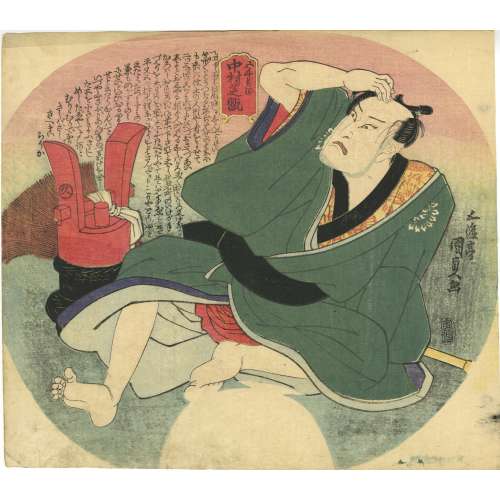 Artist: Utagawa Kunisada [歌川 国貞] a.k.a. Utagawa Toyokuni III [三代歌川豊国] (Japanese, 1786 – 1865). Signed: Gototei Kunisada ga [五渡亭国貞画]. Publisher: Ibaya Kyūbei [伊場屋 久兵衛] (Japanese, 1804 – 1851); seal Marks 08-055|126a. Date-aratame seal: Bunsei 13 / Tenpō 1 (1830). Actor: Nakamura Utaemon IV [中村歌右衛門] (Japanese, 1796 – 1852); other names: Nakamura Shikan II [中村芝翫], Nakamura Tsurusuke I, Nakamura Tōtarō. Play: Yoshitsune’s Letter at Koshigoe [義経腰越状] (Yoshitsune Koshigoe-jo). Uncut fan print (uchiwa-e, 団 扇 絵) depicting kabuki actor Nakamura Shikan [中村芝翫] as Gotobei [五斗兵衛], dressed in a green kimono with hanging wisteria crest (sagari fuji mon) on the shoulder, posing behind a large saké cask. Nakamura Utaemon IV held the name of Nakamura Shikan II from the 11th lunar month of 1825 to the 1st lunar month of 1836. He was born as Hirano Kichitarō in Edo in 1796. Another fan print with the same subject in this collection [SVJP-0349.2021]; there are also more details about the play and its heroes.
Artist: Utagawa Kunisada [歌川 国貞] a.k.a. Utagawa Toyokuni III [三代歌川豊国] (Japanese, 1786 – 1865). Signed: Gototei Kunisada ga [五渡亭国貞画]. Publisher: Ibaya Kyūbei [伊場屋 久兵衛] (Japanese, 1804 – 1851); seal Marks 08-055|126a. Date-aratame seal: Bunsei 13 / Tenpō 1 (1830). Actor: Nakamura Utaemon IV [中村歌右衛門] (Japanese, 1796 – 1852); other names: Nakamura Shikan II [中村芝翫], Nakamura Tsurusuke I, Nakamura Tōtarō. Play: Yoshitsune’s Letter at Koshigoe [義経腰越状] (Yoshitsune Koshigoe-jo). Uncut fan print (uchiwa-e, 団 扇 絵) depicting kabuki actor Nakamura Shikan [中村芝翫] as Gotobei [五斗兵衛], dressed in a green kimono with hanging wisteria crest (sagari fuji mon) on the shoulder, posing behind a large saké cask. Nakamura Utaemon IV held the name of Nakamura Shikan II from the 11th lunar month of 1825 to the 1st lunar month of 1836. He was born as Hirano Kichitarō in Edo in 1796. Another fan print with the same subject in this collection [SVJP-0349.2021]; there are also more details about the play and its heroes.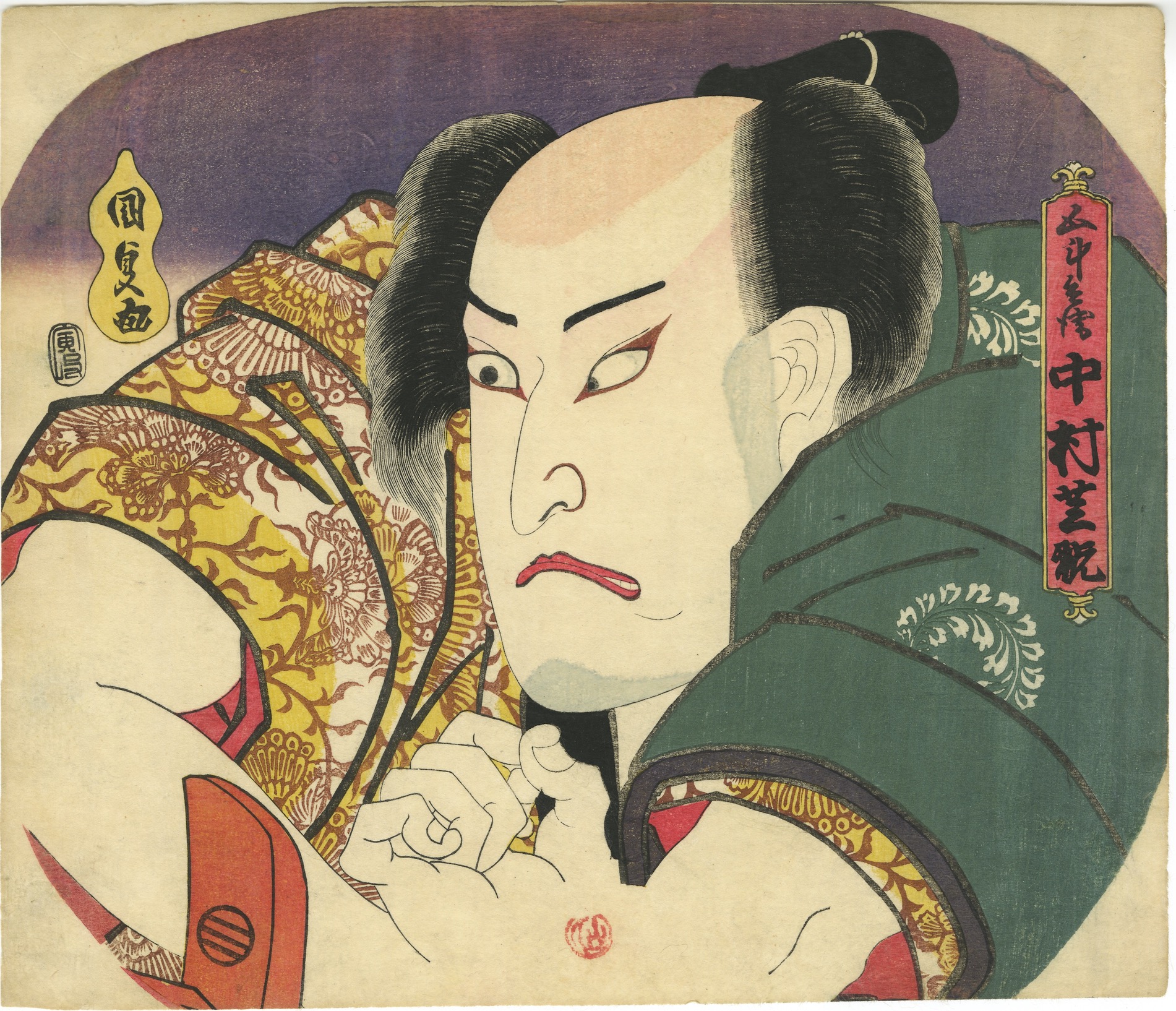 Horst Graebner also noted that the performance took place at Nakamura Theatre in Edo on Bunsei 13/03 (03/1830) (see Waseda University Cultural Resources Database # 100-4224):
Horst Graebner also noted that the performance took place at Nakamura Theatre in Edo on Bunsei 13/03 (03/1830) (see Waseda University Cultural Resources Database # 100-4224):
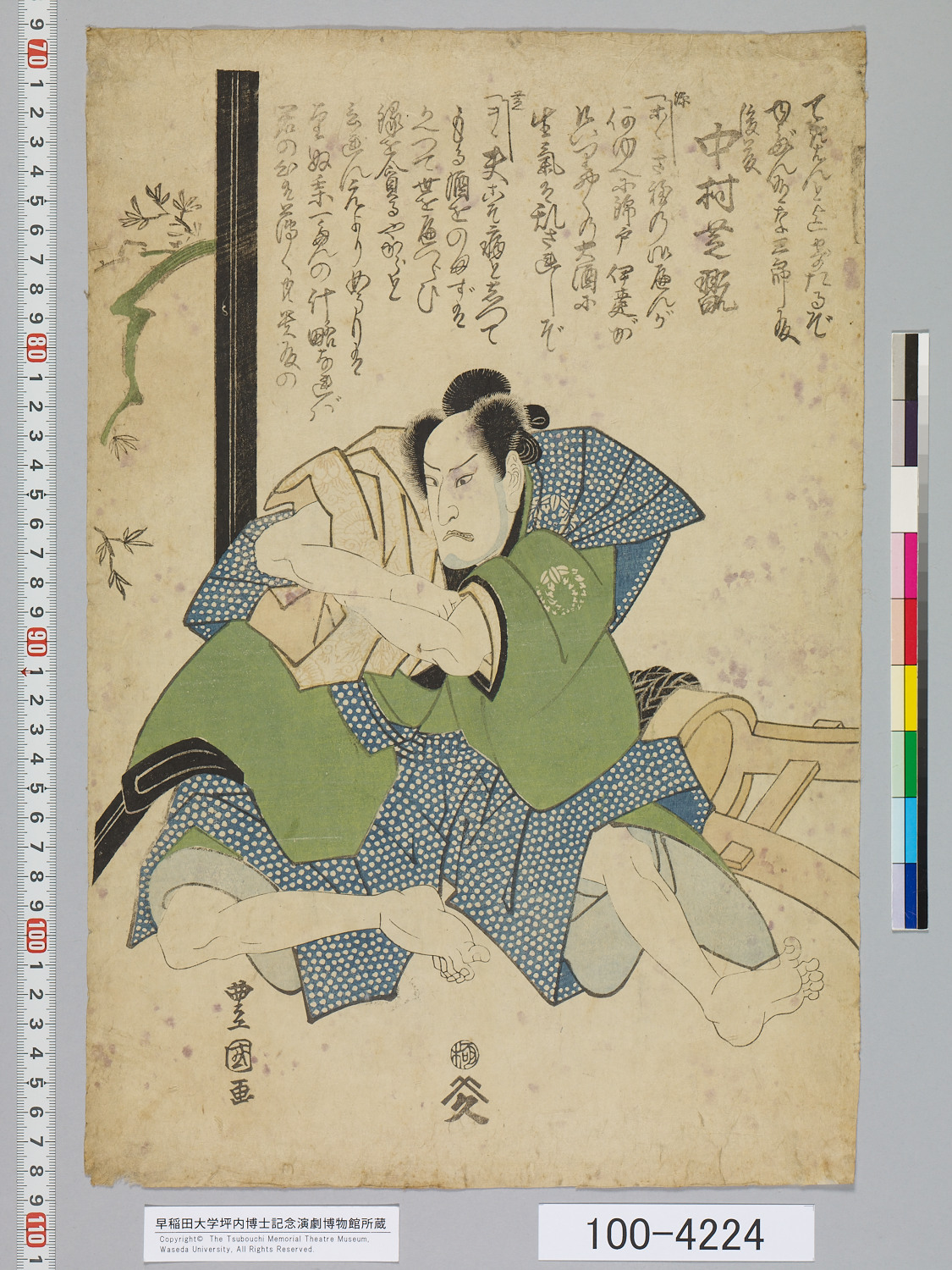
Toyokuni II
-
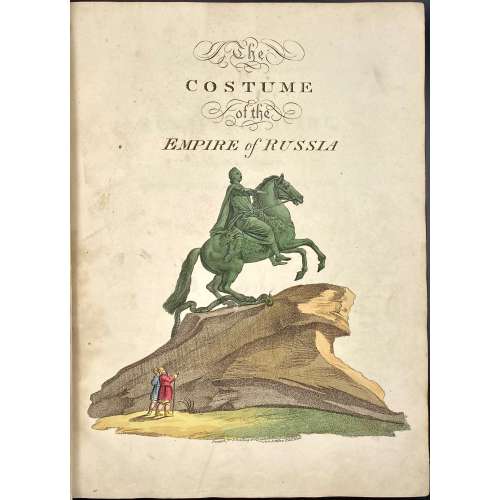 Engraved title: The | Costume | of the | Empire of Russia | {copper horseman vignette} | signed under: Printed for E. Harding at the Crown and Mitre Pall Mall || English title: COSTUME | OF THE | RUSSIAN EMPIRE, | ILLUSTRATED BY UPWARDS OF | SEVENTY RICHLY COLOURED ENGRAVINGS. | DEDICATED BY PERMISSION TO | HER ROYAL HIGHNESS | THE | PRINCESS ELIZABETH. | LONDON: | PRINTED BY T. BENSLEY, BOLT COURT, FLEET STREET; | FOR JOHN STOCKDALE, PICCADILLY. | 1811. || Paper: thick wove paper, the leaf with “Copper Horseman” watermarked J. Whatman 1808; the French title – Edmeads & Co 1809, E2 – E & P 1807, plates are not watermarked [NYPL: An “1803” copy of The Costumes of the Russian Empire has watermarks from 1796 (W Elgar), 1809 (Edmeads & Co), 1811, 1813 (J. Whatman), 1818, and 1829]. Collation: 4to; (1) engraved title by E. Harding (“Copper Horseman” monument of Peter the Great), (2) English title, (3) French title, (4) Dedication to her Royal Highness the Princess Elizabeth by E. Harding (1803), (5) Contents —> π5 a2 B-S4 T2, all second leaves in all quires but C and T signed “2”, 77 leaves total, unpaginated, plus 72 plates (34.5 x 25.5 cm), stipple and line engravings, hand-coloured, by John Dadley after William Alexander. Binding: 36 x 27 cm, straight-grain green morocco, blind-stamped palmette border withing gilt-stamped palmette border to boards, raised bands decorated in gilt, gilt in compartments, two brown morocco labels with gilt lettering, brown endpapers, 2 additional flyleaves at front and back, AEG. Authorship and artistic work are attributed to Alexander and Dadley, but not signed. 1st edition in 1803 was published by William Richard Beckford Miller (British, 1769 – 1844). Catalogue raisonné: Tooley (1906): p. 151. Contributors: William Alexander (British, 1767 – 1816) – artist, author. John Dadley (British, 1767 – 1817) – engraver. Thomas Bensley (British, 1759 – 1835) – printer. John Stockdale (British, 1750 – 1814) – publisher. Edward Harding (British, 1755 – 1840) – publisher of 1803 edition (author of dedication) Princess Elizabeth of the United Kingdom (British, 1770 – 1840) – dedicatee.
Engraved title: The | Costume | of the | Empire of Russia | {copper horseman vignette} | signed under: Printed for E. Harding at the Crown and Mitre Pall Mall || English title: COSTUME | OF THE | RUSSIAN EMPIRE, | ILLUSTRATED BY UPWARDS OF | SEVENTY RICHLY COLOURED ENGRAVINGS. | DEDICATED BY PERMISSION TO | HER ROYAL HIGHNESS | THE | PRINCESS ELIZABETH. | LONDON: | PRINTED BY T. BENSLEY, BOLT COURT, FLEET STREET; | FOR JOHN STOCKDALE, PICCADILLY. | 1811. || Paper: thick wove paper, the leaf with “Copper Horseman” watermarked J. Whatman 1808; the French title – Edmeads & Co 1809, E2 – E & P 1807, plates are not watermarked [NYPL: An “1803” copy of The Costumes of the Russian Empire has watermarks from 1796 (W Elgar), 1809 (Edmeads & Co), 1811, 1813 (J. Whatman), 1818, and 1829]. Collation: 4to; (1) engraved title by E. Harding (“Copper Horseman” monument of Peter the Great), (2) English title, (3) French title, (4) Dedication to her Royal Highness the Princess Elizabeth by E. Harding (1803), (5) Contents —> π5 a2 B-S4 T2, all second leaves in all quires but C and T signed “2”, 77 leaves total, unpaginated, plus 72 plates (34.5 x 25.5 cm), stipple and line engravings, hand-coloured, by John Dadley after William Alexander. Binding: 36 x 27 cm, straight-grain green morocco, blind-stamped palmette border withing gilt-stamped palmette border to boards, raised bands decorated in gilt, gilt in compartments, two brown morocco labels with gilt lettering, brown endpapers, 2 additional flyleaves at front and back, AEG. Authorship and artistic work are attributed to Alexander and Dadley, but not signed. 1st edition in 1803 was published by William Richard Beckford Miller (British, 1769 – 1844). Catalogue raisonné: Tooley (1906): p. 151. Contributors: William Alexander (British, 1767 – 1816) – artist, author. John Dadley (British, 1767 – 1817) – engraver. Thomas Bensley (British, 1759 – 1835) – printer. John Stockdale (British, 1750 – 1814) – publisher. Edward Harding (British, 1755 – 1840) – publisher of 1803 edition (author of dedication) Princess Elizabeth of the United Kingdom (British, 1770 – 1840) – dedicatee. -
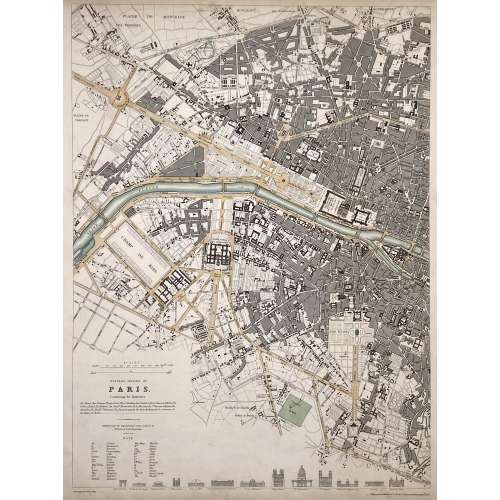 WESTERN DIVISION OF | PARIS. | Containing the Quartiers | {4 lines in italic} | Published under the Superintendence of the Society for the | Diffusion of Useful Knowledge || Under the frame: Drawn by W. B. Clarke, Archt. […] Published by Baldwin & Cradock, 47 Paternoster Row, April 1st. 1834. Dimensions: Sheet: 40.5 x 34.5 cm; Image: 39 x 28.8 cm. Contributors: William Barnard Clarke (British, 1806 – 1865) – artist. John Shury (fl. c. 1814-1844) – engraver. Baldwin & Cradock (London) – publisher. Society for the Diffusion of Useful Knowledge (SDUK) (British firm, 1826 – 1846).
WESTERN DIVISION OF | PARIS. | Containing the Quartiers | {4 lines in italic} | Published under the Superintendence of the Society for the | Diffusion of Useful Knowledge || Under the frame: Drawn by W. B. Clarke, Archt. […] Published by Baldwin & Cradock, 47 Paternoster Row, April 1st. 1834. Dimensions: Sheet: 40.5 x 34.5 cm; Image: 39 x 28.8 cm. Contributors: William Barnard Clarke (British, 1806 – 1865) – artist. John Shury (fl. c. 1814-1844) – engraver. Baldwin & Cradock (London) – publisher. Society for the Diffusion of Useful Knowledge (SDUK) (British firm, 1826 – 1846). -
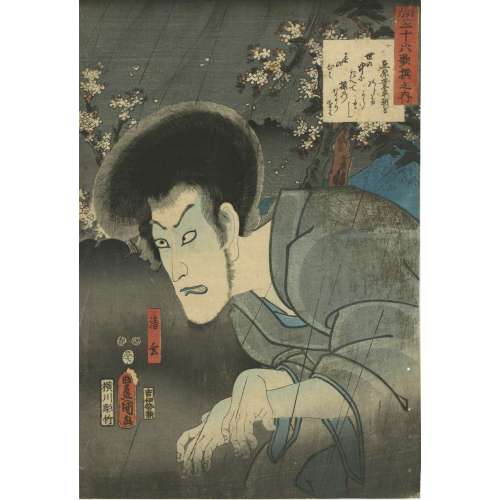 Poem by Ariwara no Narihira Ason: (Actor Ichikawa Danjûrô VIII as) Seigen, from the series Comparisons for Thirty-six Selected Poems (Mitate sanjûrokkasen no uchi)「見立三十六歌撰之内 有原業平朝臣 清玄」 八代目市川団十郎. Poem: Yo no naka ni/ taete sakura no/ nakariseba/ haru no kokoro wa/ nodokekaramashi. Kabuki actor: Ichikawa Danjūrō VIII [八代目 市川 團十郎] (Japanese, 1823 – 1854); other names: Ichikawa Ebizô VI, Ichikawa Shinnosuke II. Artist: Utagawa Kunisada [歌川 国貞] a.k.a. Utagawa Toyokuni III [三代歌川豊国] (Japanese, 1786 – 1865). Block cutter: Yokokawa Horitake [横川彫武] a.k.a. Yokokawa Takejiro [横川竹二郎] (Japanese, fl. 1860s). Publisher: Iseya Kanekichi [伊勢屋兼吉] (Japanese, fl. 1840s – c. 1875) Year: 1852 (Kaei 5), 10th month. Size: Vertical ōban; 36.5 × 25.4 cm. Signed: Toyokuni ga, in toshidama cartouche [豊国画(年玉枠] Censors' seals: Fuku, (Muramatsu), Rat 10. Ref: MFA Accession № 11.36779.43.
Poem by Ariwara no Narihira Ason: (Actor Ichikawa Danjûrô VIII as) Seigen, from the series Comparisons for Thirty-six Selected Poems (Mitate sanjûrokkasen no uchi)「見立三十六歌撰之内 有原業平朝臣 清玄」 八代目市川団十郎. Poem: Yo no naka ni/ taete sakura no/ nakariseba/ haru no kokoro wa/ nodokekaramashi. Kabuki actor: Ichikawa Danjūrō VIII [八代目 市川 團十郎] (Japanese, 1823 – 1854); other names: Ichikawa Ebizô VI, Ichikawa Shinnosuke II. Artist: Utagawa Kunisada [歌川 国貞] a.k.a. Utagawa Toyokuni III [三代歌川豊国] (Japanese, 1786 – 1865). Block cutter: Yokokawa Horitake [横川彫武] a.k.a. Yokokawa Takejiro [横川竹二郎] (Japanese, fl. 1860s). Publisher: Iseya Kanekichi [伊勢屋兼吉] (Japanese, fl. 1840s – c. 1875) Year: 1852 (Kaei 5), 10th month. Size: Vertical ōban; 36.5 × 25.4 cm. Signed: Toyokuni ga, in toshidama cartouche [豊国画(年玉枠] Censors' seals: Fuku, (Muramatsu), Rat 10. Ref: MFA Accession № 11.36779.43.



